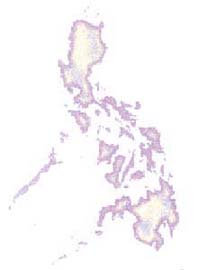
Carl Rubino
Australian National University
Published in Amida Magazine 4:4, 1998.
Tagálog (Pilipino) was officially declared the national language of the Philippines (wikang pambansâ ng Pilipinas) on July 4, 1946 following a law drafted six years before. With over 90 distinct languages in the country, the Philippine government deemed it necessary to choose one of them as the basis for a national language. Contenders for this title included the eight 'major' languages of the archipelago (languages having at least one million speakers, see map), but the final round boiled down to two top contenders: Cebuano, with the largest number of native speakers, and Tagalog, the language of Manila, the capital. To the utter joy of many Manileños, Tagalog won, and from this day non-Tagalog first graders are required to learn Tagalog.
Filipinos are taught at an early age that Pilipino is truly a national
language, created using the maugnayin 'amalgamating' approach of
selecting a vocabulary that is representative of all of the languages
of the archipelago, with Tagalog serving as the standard. In reality,
very few words native to the country used in Pilipino are of non-Tagalog
origin, new words are often coined from the colonial European languages
which still have official status: English and Spanish.
 |
The modernisation of Tagalog was originally left in the hands of the National Language Academy which wrote the official balarilà 'grammar' and attempted to fill many lexical deficiencies. The Lupon sa Aghám 'Committee on Science' was also responsible for coining words relating to science. Tagalog, for instance, does not have a word for 'gravity'. The Lupon sa Agham immediately recognised that an Ilocano word, dagsen nearly expressed the cognate ideas of weightiness and seriousness, and adopted it, changing it to dagsin to fit the phonetics of Tagalog. Since Tagalog is a morphologically complex language (has many affixes, prefixes, suffixes and even infixes), it was relatively easy to coin new derivations also from dagsin 'gravity'. Among those proposed were kadagsinan 'gravitation', kadagsinain 'gravitational', dagsinsukatin 'gravimetric', dagsinsukatan 'gravimetry', dumagsin 'gravitate', and dumadagsin 'gravitating'. |
Tagalog, like its sister Philippine languages, is an Austronesian language distantly related to the languages of most of Indonesia, Madagascar, aboriginal Taiwan, most Pacific isles, and parts of New Guinea. Because it has borrowed many words from Spanish, people are likely to think that Tagalog and Spanish are related. Such is not the case. The syntax of Tagalog has not been affected much from over three hundred years of Spanish colonisation.
The structure of Tagalog. Tagalog is a morphologically complex,
predicate-initial language, in which the predicate (in many cases, a verb)
occupies the initial slot of a sentence:
Umiyák ang batà = cried the child = The child cried.
Tagalog verbs inflect for aspectual distinctions, as English verbs inflect for tense: Umiiyak ang batà 'The child is crying', Iiyák ang batà 'The child will cry'.
Some noteworthy aspects of Tagalog include its 'focus' system in which
the nature of the noun in focus is reflected in the verb (see how the bolded
Tagalog verb changes form to correspond to the English bolded noun):
Bumili ka ng manggá sa palengke para sa akin.
You bought mangos at the market for me.
Bilhín mo ang manggá sa palengke para sa akin.
Buy the mangos at the market for me.
Bilhán mo ako ng manggá sa palengke.
Buy mangos for me at the market.
Ibilí mo akó ng manggá sa palengke.
Buy mangos for me at the market.
Ipambilí mo ng manggá ang pera ko.
Buy mangos with my money.
Tagalog pronouns do not encode gender. 'He' and 'she' are both expressed with siya. Gender, however, is encoded in some nouns: ate 'older sister' vs. kuya 'older brother'. You may have noticed your Tagalog friends mixing genders every now and then when referring to the same person. Be assured that this does not influence their ability to distinguish gender in the natural world.
Many people have asked me about how different Philippine languages really
are. Aside from telling you that monolingual speakers of Tagalog cannot
understand even the simplest of Ilocano conversations, or vice-versa, I
leave you with the most popular Philippine proverb translated into six
Philippine languages. You may notice some structural similarities (i.e.
word order) but should see that the differences are quite substantial.
Aren't you glad you weren't forced to learn Tagalog in first grade?
PILIPINO PROVERB: "He who does not look back at his past will
not reach his destination."
Palawano: Ang indi nakaelam ang anang ing alinan, indi na maelaman anang papakunan.
Ilocano: No saan nga makaammo a mangtaliaw iti naggapuanna, saan a makadanon iti papananna.
Tagalog: Ang di lumilingón sa pinanggalingan, di makaratíng sa paroroonan.
Bikol: Ang dai nalingoy sa hinalean, dai makaabot sa padudumanan.
Ibanag: Y tolay nga ari mallipay ta naggafuanna, ari makadde ta angayan na.
Ilianen Manobo: Ke etew ne kena
edlilingey te inpuun din ne kena ebpekeuma diya te edtamanan din.
Click here for a sample of the pre-Hispanic Tagalog syllabary or HERE for the Ilocano syllabary.
Click here if you have never seen a WEEDY SEA DRAGON.
See the Povedano calendar taken from the 1572 Povedano manuscript. Its pre-Hispanic origin is dubious, but it is nevertheless quite pretty to look at.
Go to the webpage of Philippine Linguists.